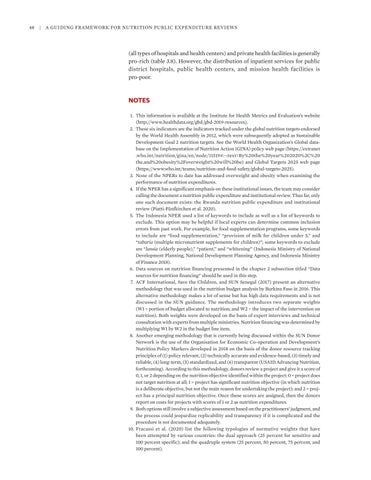48
| A Guiding Framework for Nutrition Public Expenditure Reviews
(all types of hospitals and health centers) and private health facilities is generally pro-rich (table 3.8). However, the distribution of inpatient services for public district hospitals, public health centers, and mission health facilities is pro-poor.
NOTES 1. This information is available at the Institute for Health Metrics and Evaluation’s website (http://www.healthdata.org/gbd/gbd-2019-resources). 2. These six indicators are the indicators tracked under the global nutrition targets endorsed by the World Health Assembly in 2012, which were subsequently adopted as Sustainable Development Goal 2 nutrition targets. See the World Health Organization’s Global database on the Implementation of Nutrition Action (GINA) policy web page (https://extranet .who.int/nutrition/gina/en/node/11519#:~:text=By%20the%20year%202020%2C%20 the,and%20obesity%2Foverweight%20will%20be) and Global Targets 2025 web page (https://www.who.int/teams/nutrition-and-food-safety/global-targets-2025). 3. None of the NPERs to date has addressed overweight and obesity when examining the performance of nutrition expenditures. 4. If the NPER has a significant emphasis on these institutional issues, the team may consider calling the document a nutrition public expenditure and institutional review. Thus far, only one such document exists: the Rwanda nutrition public expenditure and institutional review (Piatti-Fünfkirchen et al. 2020). 5. The Indonesia NPER used a list of keywords to include as well as a list of keywords to exclude. This option may be helpful if local experts can determine common inclusion errors from past work. For example, for food supplementation programs, some keywords to include are “food supplementation,” “provision of milk for children under 5,” and “taburia (multiple micronutrient supplements for children)”; some keywords to exclude are “lansia (elderly people),” “patient,” and “whitening” (Indonesia Ministry of National Development Planning, National Development Planning Agency, and Indonesia Ministry of Finance 2018). 6. Data sources on nutrition financing presented in the chapter 2 subsection titled “Data sources for nutrition financing” should be used in this step. 7. ACF International, Save the Children, and SUN Senegal (2017) present an alternative methodology that was used in the nutrition budget analysis by Burkina Faso in 2016. This alternative methodology makes a lot of sense but has high data requirements and is not discussed in the SUN guidance. The methodology introduces two separate weights (W1 = portion of budget allocated to nutrition; and W2 = the impact of the intervention on nutrition). Both weights were developed on the basis of expert interviews and technical consultation with experts from multiple ministries. Nutrition financing was determined by multiplying W1 by W2 in the budget line item. 8. Another emerging methodology that is currently being discussed within the SUN Donor Network is the use of the Organisation for Economic Co-operation and Development’s Nutrition Policy Markers developed in 2018 on the basis of the donor resource tracking principles of (1) policy relevant, (2) technically accurate and evidence-based, (3) timely and reliable, (4) long-term, (5) standardized, and (6) transparent (USAID Advancing Nutrition, forthcoming). According to this methodology, donors review a project and give it a score of 0, 1, or 2 depending on the nutrition objective identified within the project: 0 = project does not target nutrition at all; 1 = project has significant nutrition objective (in which nutrition is a deliberate objective, but not the main reason for undertaking the project); and 2 = project has a principal nutrition objective. Once these scores are assigned, then the donors report on costs for projects with scores of 1 or 2 as nutrition expenditures. 9. Both options still involve a subjective assessment based on the practitioners’ judgment, and the process could jeopardize replicability and transparency if it is complicated and the procedure is not documented adequately. 10. Fracassi et al. (2020) list the following typologies of normative weights that have been attempted by various countries: the dual approach (25 percent for sensitive and 100 percent specific); and the quadruple system (25 percent, 50 percent, 75 percent, and 100 percent).

